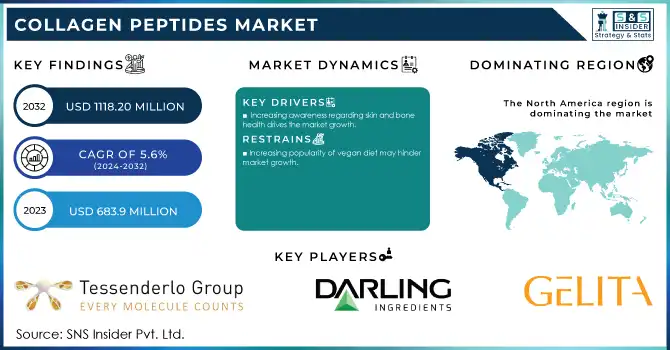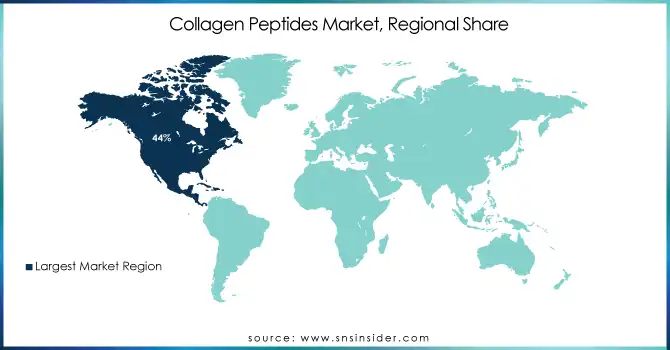Collagen Peptides Market Report Scope & Overview:
The Collagen Peptides Market size was USD 683.9 Million in 2023 and is expected to reach USD 1118.20 Million by 2032 and grow at a CAGR of 5.6% over the forecast period of 2024-2032.

Get E-PDF Sample Report on Collagen Peptides Market - Request Sample Report
The increasing need for nutritional products is an essential factor that is driving the growth of the collagen peptides market. The increasing number of people, who are becoming aware of a lot of health advantages of collagen peptides like, improved skin elasticity, joint health, and muscle recovery is boosting their demand for various dietary supplements and functional foods too. Moreover, the global trend of preventative healthcare has driven consumers to include collagen products in their daily routines. As the demand for clean-label, high-protein, and nutrient-dense clean-label products continues to rise, collagen peptides are an increasingly popular ingredient in products oriented towards welfare. As manufacturers respond by introducing novel formulations of powder, drinks, and capsules, in particular, to meet consumers' needs the market keeps expanding.
In January 2023, Youtheory expanded its collagen-based "Beauty On-The-Go" product line into the Japanese market, catering to the growing demand. This expansion helps the company to increase its presence in the market.
The collagen peptides market all over the world will be led by the sports nutrition segment due to raising awareness regarding collagen regarding athletic performance and recovery. As a source of this protein, collagen peptides are high in amino acids such as glycine, proline, and hydroxyproline to help with muscle rebuilding, healthy joints, and strong connective tissue. As a result of the increased fitness-related activities across the world in terms of recreational sports and using gym membership, many people are increasingly looking for safe and natural supplements to help enhance performance potentially and reduce potential injury.
In 2023, approximately 242 million Americans, representing 78.8% of the population, engaged in physical activities at least once, marking a 2.2% increase from the previous year.
Collagen Peptides Market Dynamics
Drivers
-
Increasing awareness regarding skin and bone health drives the market growth.
Rising awareness regarding skin & bone health is one of the most significant factors that are expected to boost the growth of the collagen peptides market. With consumers learning more about the aging process with regard to skin elasticity and joint mobility, integrative solutions to address these mechanisms of action have much broader attractiveness. Collagen, a major protein in skin, bones and connective tissues, declines with age, resulting in wrinkles, sagging skin and joint pain. Consequently, market demand for collagen peptides used to moisturize the skin, smooth signs of aging, promote joint mobility and increase bone mass are increasingly in demand. Higher awareness regarding the beneficial use of collagen for the treatment of various disorders such as osteoarthritis and osteoporosis is also propelling its use in dietary supplements, pharmaceuticals, functional foods and nutraceuticals and skin care products. With a growing desire to look for more natural and proven solutions to keep their skin and bone health, collagen peptides leading the way is an ongoing trend.
Increasing awareness about skin and bone health is significantly driving the growth of the collagen peptides market in India. Studies indicate that approximately 25 million Indians may be affected by osteoporosis, a condition characterized by low bone mass and increased fracture risk.
Restraint
-
Increasing popularity of vegan diet may hinder market growth.
Vegan diets becoming more prevalent is another important reason why the collagen peptides market has been expanding. With more people choosing a plant-based lifestyle for ethical, environmental, or health-related reasons, the demand for vegan alternatives to traditional, animal-derived collagen has been increasing. Plant-based substitutes made from algae, fungi, and soy are replacing collagen peptides that are generally made from animal skin and bones. They provide comparable advantages to collagen, underscoring their contributions to healthy skin, strong joints, and overall vitality, all the while providing consumers an ethical and sustainable option. With increasing awareness of the environmental effect of animal agriculture, the transition to plant-based diets is taking place at a faster pace, and thus, augmenting the demand for plant-based collagen products. This trend is in keeping with the general drive of the clean-label, sustainable and ethical ingredient movement and will keep the collagen peptides market relevant for the increasing population of vegans.
Opportunities
-
Increasing collagen peptides demand as a health supplement by health-conscious people in the emerging economies
-
Increasing investments in the R&D activities
Collagen Peptides Market Segmentation
By Source
Bovine held the largest market share around 45% in 2023. It is owing to factors such as, high availability, low cost and better bioavailability. Bovine collagen is one of the most common and widely used collagen because it is high in Type I and Type III collagen that is needed to maintain healthy skin, bones, and joints; bovine collagen comes from cows. So it works much better for skin elasticity, wrinkles and joint supplementation. Moreover, as bovine collagen is produced widely because of the cattle industry, it tends to be cheaper than other collagen sources like marine or porcine collagen. Bovine collagen has been around for a while so the supply chains and the processing mean have been established, so it will continue to dominate and stick as the best choice for manufacturers that want to remove collagen peptides due to economic viability and quality. Moreover, bovine collagen can be used in supplements, functional food, skincare products and the medical devices and in turn contribute to uphold its largest reigning position in the global collagen market.
By Form
Dry held the largest market share around 67% in 2023. This trend continues with the liquid form of collagen peptide. The secret is the good availability of dry collagen peptides, the long shelf life and simple transport arrangements. The most common form of dry collagen in powder form is very easy to mix into supplements, smoothies, protein bars, and other food products. Because of its stability and lower risk of spoilage, it is more preferred by both manufacturers and consumers. Moreover, the dry collagen peptide form is more storable and lighter in transport, resulting in lower shipping costs and less consumer cost on a much more commercial scale. Dry collagen is versatile and can be used in dietary supplements and functional food, which is another main driver of its leading market position. Although liquid collagen is much easier to consume and can increase popularity in market, it has a shorter shelf life and higher transportation cost, thus resulting in low market share compared to its dry form.
By Application
Food & Beverage held the largest market share around 38% in 2023. This is largely attributed to the growing demand for functional foods and beverages enriched with collagen, as consumers increasingly understand the benefits of this protein for your skin, joints, and health. Due to the soluble-type nature of collagen peptide, they are highly versatile and can be easily included into many food and beverage product categories such as protein bars, beverages, soup, snack, and dairy products. The increasing shift towards health-oriented consumption, combined with an increased demand for natural and functional ingredients, has contributed to the high popularity of collagen peptides in the food beverage market. Further, collagen-related products that are easy to consume and infused with additional benefits, including skin elasticity, joint support, and recovery benefits, are in high demand among consumers. Collagen peptides have penetrated deep into day-to-day food and drink preparations helping it retain the top-most position in the market. Although other sectors, including cosmetics, personal care and pharmaceutical, also drive market upturn, still the food & beverage sector is the largest contributor owing to the large consumer base and innovation in product formulations.
Collagen Peptides Market Regional Analysis
North America held the largest market share around 44% in 2023. It owing to high demand for health and wellness products, high consumer knowledge of the use of these types of products, and many of the leading manufacturers operating in this region. More recently, collagen-based supplements, functional foods, and beverages have exploded in popularity globally, and especially in the United States, fueled in large part by increased interest in skin health, joint support, and overall wellness. With the growing demand within consumers from North America for natural and effective solutions to stabilize the aging process, overcome mobility issues and improve beauty, the consumption of collagen peptides is amplifying. Furthermore, established healthcare infrastructure, developed retail environment, and distribution channels enable wide accessibility of collagen peptides in the region, receiving sales utilization in vast population. Moreover, North America consists of some collagen peptides manufacturers and brands that are stitching innovations and better products for its growth. The confluence of consumer demand and industry presence coupled with innovation has placed North America as the dominant market for collagen peptides across the globe.

Get Customized Report as per Your Business Requirement - Enquiry Now
Key Players
-
Tessenderlo Group (Gelita Collagen Peptides, TeloGenesis)
-
Darling Ingredients (Collagen Hydrolysate, Vital Proteins Collagen)
-
GELITA AG (Collagen Peptides, Gelita Skin)
-
Holista Colltech (Holista Collagen, Holista Beauty Collagen)
-
Collagen Solutions Plc (Collagen Peptide Powder, Collagen Gel)
-
Nitta Gelatin India Limited (Collagen Peptides, Gelatin)
-
Amicogen (Peptan Collagen, Peptide-X™)
-
Gelnex (Hydrolyzed Collagen, Gelatin Capsules)
-
FOODMATE CO., LTD. (Collagen Peptide Powder, Collagen-based Supplement)
-
Ewald-Gelatine GmbH (Gelatin, Collagen Hydrolysates)
-
Rousselot (Peptan Collagen Peptides, Rousselot Gelatin)
-
BIOCELL Technology (BioCell Collagen II, Hydrolyzed Collagen)
-
Vital Proteins (Collagen Peptides Powder, Marine Collagen)
-
Seagarden (Marine Collagen, Collagen Peptide Powder)
-
Vinh Hoan Corporation (Fish Collagen, Hydrolyzed Collagen)
-
NCL Nutrition (Collagen Peptides, Collagen Protein)
-
Ingredion (Collagen Peptide Powder, Gellan Gum)
-
Kenko Collagen (Kenko Collagen Peptides, Skin Collagen)
-
Peptan (Peptan Collagen Peptides, Peptan Food Supplement)
-
Neocell (Super Collagen, Collagen Type 1 & 3)
Recent Development:
-
In 2024, Tessenderlo Group launched TeloGenesis, a new line of collagen peptides targeted at improving skin elasticity and joint health. This product caters to the rising demand for functional ingredients in the cosmetic and wellness industries.
-
In 2023, Darling Ingredients expanded its Vital Proteins Collagen range by introducing new flavored collagen peptides targeted at consumers looking for healthier protein alternatives in their beverages and snacks.
-
In 2023, GELITA launched a new Gelita Skin Collagen Peptides specifically formulated to improve skin hydration and elasticity, addressing the growing demand for beauty-from-within products.
| Report Attributes | Details |
| Market Size in 2023 | US$ 683.9 Million |
| Market Size by 2032 | US$ 1118.20 Million |
| CAGR | CAGR of 5.6% From 2024 to 2032 |
| Base Year | 2023 |
| Forecast Period | 2024-2032 |
| Historical Data | 2020-2022 |
| Report Scope & Coverage | Market Size, Segments Analysis, Competitive Landscape, Regional Analysis, DROC & SWOT Analysis, Forecast Outlook |
| Key Segments | • By Source (Bovine, Porcine, Marine, and Poultry) • By Form (Dry and Liquid) • By Application (Food and Beverage, Nutritional Products, Cosmetics & Personal Care, and Pharmaceuticals) |
| Regional Analysis/Coverage | North America (US, Canada, Mexico), Europe (Eastern Europe [Poland, Romania, Hungary, Turkey, Rest of Eastern Europe] Western Europe] Germany, France, UK, Italy, Spain, Netherlands, Switzerland, Austria, Rest of Western Europe]), Asia Pacific (China, India, Japan, South Korea, Vietnam, Singapore, Australia, Rest of Asia Pacific), Middle East & Africa (Middle East [UAE, Egypt, Saudi Arabia, Qatar, Rest of Middle East], Africa [Nigeria, South Africa, Rest of Africa], Latin America (Brazil, Argentina, Colombia, Rest of Latin America) |
| Company Profiles | Tessenderlo Group, Darling Ingredients, GELITA AG, Holista Colltech, Collagen Solutions Plc, Nitta Gelatin India Limited, Amicogen, Gelnex, FOODMATE CO., LTD., and Ewald-Gelatine GmbH., and other |
| Key Drivers | • Increasing awareness regarding skin and bone health drives the market growth. |
| Market Opportunities | • Increasing collagen peptides demand as a health supplement by health-conscious people in the emerging economies • Increasing investments in the R&D activities |

